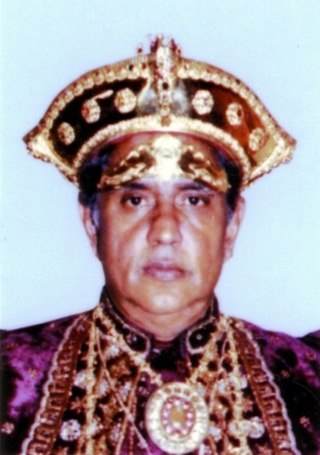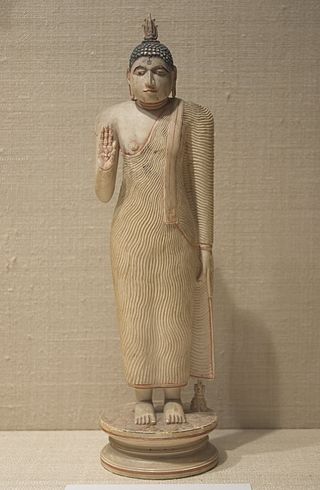
The history of Sri Lanka is unique because its relevance and richness extend beyond the areas of South Asia, Southeast Asia and the Indian Ocean. The early human remains which were found on the island of Sri Lanka date back to about 38,000 years ago.

The Sinhalese people, also known as the Sinhalese are an Indo-Aryan ethno-linguistic group native to the island of Sri Lanka. Historically, they were also known as the Helas or the Lion People. They are the largest ethnic group in Sri Lanka, constituting about 75% of the Sri Lankan population and number more than 15.2 million.

Anuradhapura is a major city located in the north central plain of Sri Lanka. It is the capital city of North Central Province and the capital of Anuradhapura District. The city lies 205 kilometers (127 mi) north of the current capital of Colombo in the North Central Province, on the banks of the historic Malwathu Oya. The city is now a World Heritage Site famous for its well-preserved ruins of the ancient Sinhalese civilisation.

Jaya Sri Maha Bodhi is a historical sacred bo tree in the Mahamewuna Garden in historical city of Anuradhapura, Sri Lanka. This is believed to be a tree grown from a cutting of the southern branch from the historical sacred bo tree, Sri Maha Bodhi, which was destroyed during the time of Emperor Ashoka the Great, at Buddha Gaya in India, under which Siddhartha Gautama (Buddha) attained Enlightenment. The Buddhist nun Sangamitta Maha Theri, a daughter of Indian Emperor Ashoka, in 236 BC, brought the tree cutting to Sri Lanka during the reign of Sinhalese King Devanampiya Tissa.[1] At more than 2,300 years old, it is the oldest living human-planted tree in the world with a known planting date. The Mahavamsa, or the great chronicle of the Sinhalese, provides an elaborate account of the establishment of the Jaya Siri Maha Bodhi on the Island and the subsequent development of the site as a major Buddhist pilgrimage site.
The Anuradhapura massacre occurred in Sri Lanka in 1985 and was carried out by the Liberation Tigers of Tamil Eelam. This was the largest massacre of Sinhalese civilians by the LTTE to date; it was also the first major operation carried out by the LTTE outside a Tamil majority area. Initially, EROS claimed responsibility for the massacre, but it later retracted the statement, and joined the PLOTE in denouncing the incident. The groups later accused the LTTE for the attack. Since then, no Tamil militant group has admitted to committing the massacre. However, state intelligence discovered that the operation was ordered by the LTTE's leader Velupillai Prabhakaran. He assigned the massacre to the LTTE Mannar commander Victor and it was executed by Victor's subordinate Anthony Kaththiar. The LTTE claimed the attack was in revenge of the 1985 Valvettiturai massacre, where the Sri Lanka Army killed 70 Tamil civilians in Prabhakaran's hometown. In 1988, the LTTE claimed that the massacre was planned and executed under the guidance of Indian intelligence agency, RAW.
The Dehiwala train bombing was a terrorist attack carried out by the Liberation Tigers of Tamil Eelam (LTTE) during the rush hour of July 24, 1996.

Christianity is a minority religion in Sri Lanka. It was introduced to the island in first century. Traditionally, after Thomas the Apostle's visit in Kerala in AD 52, Christianity is said to have been introduced to Sri Lanka because of its close geographical and commercial ties.

Deshamanya Nissanka Parakrama Wijeyeratne, known as Nissanka Wijeyeratne, was a Sri Lankan politician, civil servant, diplomat and English language poet. He was also the Diyawadana Nilame of the Sri Dalada Maligawa, Kandy from 1975 to 1985. At the time of death he was serving as the chairman of The Law and Society Trust in Sri Lanka.

The Department of National Museums is a non-ministerial government department in Sri Lanka responsible for maintaining the National Museums. There are other museum in the country run by the Department of Archaeology and the Central Cultural Fund, Sri Lanka.

The Statue of Tara is a gilt-bronze sculpture of Tara that dates from the 7th-8th century AD in Sri Lanka. Some argue it was looted from the last King of Kandy when the British annexed Kandy in the early nineteenth century, it was given to the British Museum in 1830 by the former British Governor of Ceylon, Robert Brownrigg.

A kachcheri or district secretariat is the principal government department that administrates a district in Sri Lanka. Each of the 25 districts has a kachcheri.

Buddha Smriti Park also known as Buddha Memorial Park is an urban park located on Frazer Road near Patna Junction in Patna, India. This park has been designed by Vikram Lall and developed by the Bihar Government to commemorate the 2554th birth anniversary of the Buddha. This park was inaugurated by the 14th Dalai Lama.

The Anuradhapura cross is a form of the Christian cross symbol. It is the most ancient symbol of Christianity in Sri Lanka.

Buduruwagala Archaeological Museum is a regional museum located in Buduruwagala, Sri Lanka. It was founded in 1988 and owned by Department of Archaeology of Sri Lanka.

Anuradhapura Archaeological Museum is the oldest and the largest museum belonging to the Department of Archaeology of Sri Lanka.

Vavuniya Archaeological Museum is a regional museum located in Vavuniya town, Sri Lanka. It was founded and owned by Department of Archaeology of Sri Lanka. This regional museum covers and exhibits archaeological objects that found in Vavuniya area and its surroundings.

The Department of Archaeology is a non-ministerial government department in Sri Lanka responsible for managing the archaeological heritage.

Uddika Premarathna is a Sri Lankan actor, singer, TV announcer and former member of parliament. He is an actor in Sri Lankan cinema and television.

Ivory carving is one of the traditional industries of Sri Lanka. The country's ivory carving industry has a very long history, but its origin is not yet fully understood. During the Kingdom of Kandy, ivory art became very popular and reached at its zenith. These delicate ivory works represent how Sri Lankan craftsmen mastered in this technique.















